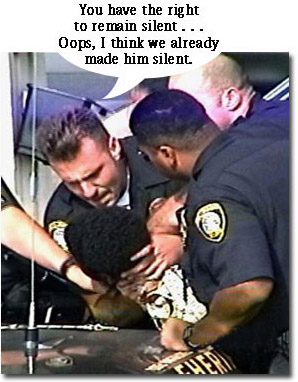
©2004, UrbisMedia
Remember Rodney King? Remember Abner Louima’s torture with a broom stick by members of the NYPD, not long after others of the boys in blue ventilated unarmed Amadou Diallo with 41 rounds? Or—back to LA—the video of highway patrolmen teeing off on he heads of a bunch of illegal immigrants?
Yes, I know that these were probably exceptional, and highly newsworthy misdeeds of those sworn to “protect and serve” that tarnished the reputations of their brothers and sisters who do dangerous and dirty work for pretty low remuneration. There are a lot of cops out there, and the laws of averages dictate that there are going to be some rotten apples, maybe slightly higher than rip-off CEOs or Halliburton number tricksters.
The bystander citizen operator of a video cam or the cameras on news helicopters have been an unsparing eye in many of the high-profile cases of police brutality. But now the police have installed them in some of their cruisers to record their activities, and some (maybe some have been “edited” out) of these to make cable reality shows of “hot pursuits” and pull-overs. It had to follow that the police would begin to “produce” their own reality shows.
I don’t know if you have had a chance or the interest in viewing one of those COPS programs on cable. I’ve gritted through a couple of them out of sociological interest, wondering whether there is a point to them other than the reality TV inanity of this stuff. But what caught my interest was that they seem to focus exclusively on the chasing, apprehension, and almost amusing overly “proper” treatment of what are uncharitably called “trailer trash” and “low life,” –semi-illiterate druggies, drunks, wife-beaters and other social dysfunctionals who almost always seem to have pockets full of syringes and lottle bags of dope. These kinds of people are really out there (Jerry Springer’s talent searchers know where they are, too), and the guys do seem to look like Billy Bob Thornton found Robert Downey Jr.’s stash, or the women are all trying to out-“monster” Charlize Theron.
But if the perps seem a bit “over the top,” the cops seem like they’re right out of the Officer Clancy finishing school. They reply to filthy curses with “Thank you maam”; struggling druggies and drooling drunks are addressed as “gentlemen”; screaming violent families are calmed with a zen-like cool restraint; and always, the heads of perps going “downtown” are carefully guided into the rear seats of police cruisers lest they bump their tender noggins and forget their Maranda rights. Rodney King would think he landed on another planet.
Is this cable TV reality feeding American voyeurism and the need to feel superior to a cohort of stupid, mean and unfortunate social bottom feeders, or is it subtly composed propaganda masquerading as “documentary”? Or both. Gone are the mirrored aviator sunglasses and the Bull Connor demeanor, these cops display a boy-next door benignity even with their Kevlar-coated burliness. No more “good cop/bad cop,” now it’s “good cop/even nicer cop.” On the cable COPS show we ride shotgun, cruising the mean streets of some city, waiting for a call, scrutinizing that corner drug deal, that suspiciously weaving pickup truck, or waiting for the radio’s incomprehensible dispatches. Snippets of the cop’s politically-correct philosophy give way to radio crackle and he insouciantly says: “we’re on our way to a 467 on the southside where a wife allegedly cut her throat on a knife that her estranged husband was holding.” (I just made up the number 467, which probably means “cat stuck in tree.”).
Many years ago, when I was studying Sociology, I read about something called the Hawthorne Effect. It was similar to Heisenberg’s physics “principle of indeterminism,” in which the very act of observation of something changes the behavior of what (or who) is being observed. The Hawthorne experiments proved the effect for social situations. The question then becomes: what would have been the real behavior, had we not been watching? Maybe you can only get the answer to that one the next time you’re pulled over as a suspect on a DUI. Just hope that they used an episode of COPS and not the Rodney King tape as a training video.
___________________________________
©2004, James A. Clapp (UrbisMedia Ltd. Pub. 3.27.2004)
